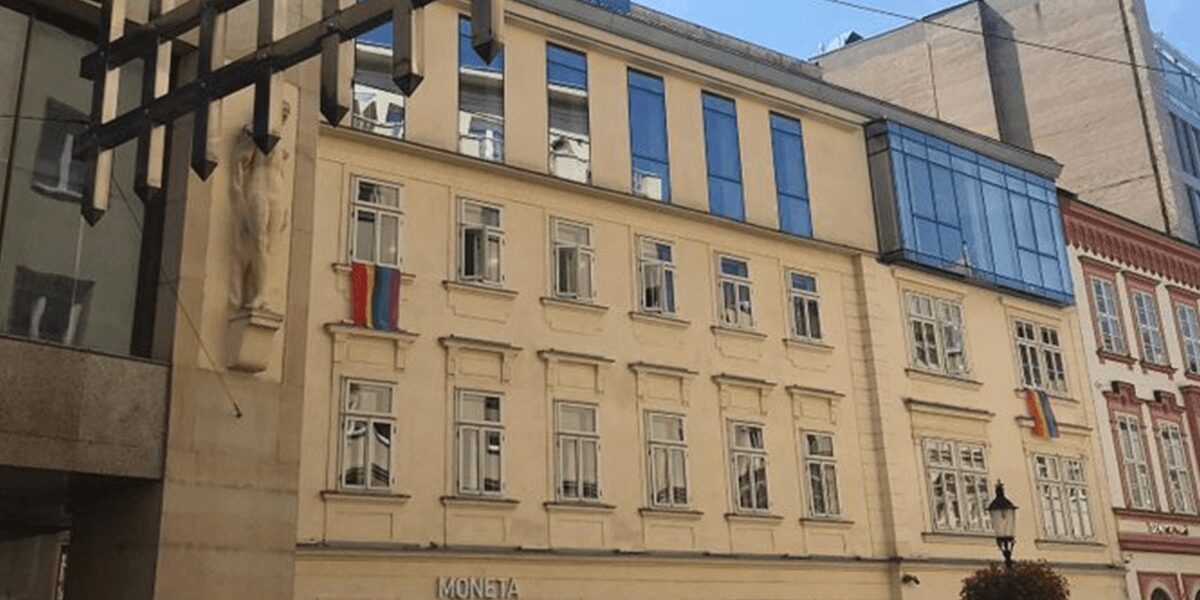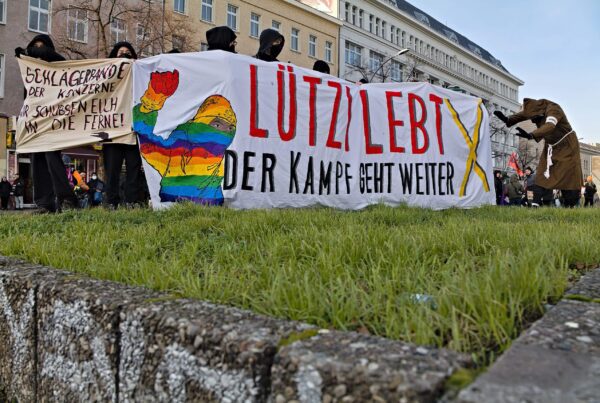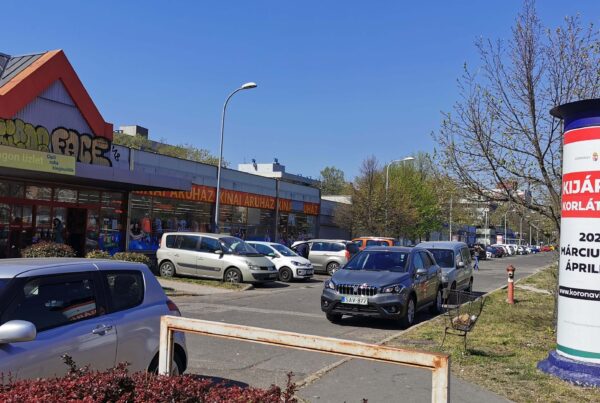In summer 2021 the Slovak company Dedoles, which sells such basic clothing items as socks and underwear, presented its rainbow collection—a reference to Pride month and the LGBTIQ community. In the face of a significant online backlash, the retailer—whose products come primarily from Turkey and China—declared that for every comment on their Facebook post about the new collection (whether positive or negative), they will donate 1 Euro to the business Fund for the Support of the LGBT+ Community run by the Slovak Pontis Foundation.
This was not the first time a company operating in Slovakia had taken a public stance concerning LGBTIQ persons. The recent involvement of companies and their employees in contentious politics in Slovakia has been so visible that it was even discussed by economist Jens Schadendorf in the ILGA Europe podcast Frontline, dedicated to private-sector initiatives:
Let’s, for instance, take the example of Slovakia. [There is a] shifting global landscape there, so there are challenges, yes, but there are also hot spots of activities already now, which are working in favor of more LGBT equality, in the civil society, but also in the corporate world.
Schadendorf’s statement referred to the recent challenges faced by the local LGBTIQ movement, but he is not the only one to have noticed the increasing involvement of businesses. In May 2022, the dominant LGBTIQ social movement organization, Iniciatíva Inakosť, organized an online event entitled Do Companies Substitute for the State in Educating about the LGBTI+ Topic?, during which various corporate activities were discussed, including the so-called LGBTIQ business employee resource groups (ERGs). In this text, I would like to reflect upon the role and agenda of ERGs in the broader LGBTIQ social movement in Slovakia, as well as discuss the potential perils of relying on and engaging in corporate political activism.
LGBTIQ Activism and Anti- “Gender Ideology” Rhetoric in Slovakia
When in 2006 the Czech Republic legalized registered partnerships for same-sex couples, a brief optimism overtook the activists of Czechia’s former counterpart, the Slovak Republic. Just two years earlier, as a condition of accession to the European Union, Slovakia had managed to institute anti-discrimination protections for sexual orientation and other characteristics. Still, these changes were not without struggle and significant opposition from nationalist and Christian-democratic political elites—and, moreover, no further successes were achieved. Indeed, as Petra Guasti and Lenka Bustikova contend, even the later inclusion of LGBTIQ persons’ concerns in a governmental advisory committee turned out to be simple window-dressing designed to alleviate international and local non-governmental pressure.
The bogus acceptance of the self-declared social-democratic governing party SMER-SD was soon to be exchanged for the support of others when corruption scandals and oppositional rhetoric toward the party started to dominate the news, as Zuzana Očenášová notes. In 2014, SMER-SD teamed up with KDH (Christian Democratic Movement) to amend the Slovak constitution to recognize heterosexual marriage alone and further legitimized the mainstreaming of anti-“gender ideology” rhetoric and its actors.
While anti-“gender ideology” rhetoric was growing steadily in prominence even before the constitutional amendment, it was the February 2015 referendum “on family” that enabled the rhetoric to spill over into mainstream politics. While ultimately unsuccessful due to low voter turnout, the mass mobilization occasioned by the referendum campaign under the auspices of the NGO Alliance for Family led to the advancement of conservative and religious political elites.
The rise of “gender ideology” rhetoric in the period prior to the 2020 parliamentary elections allowed the SMER-SD Minister of Culture to block funding for LGBTIQ-focused events in 2019, despite these projects having received positive reviews from expert evaluators. This put many key events, including Bratislava Rainbow Pride, into jeopardy. But the critical situation also sparked new mobilization by oppositional civil society and new funding initiatives, including a joint venture by the civil society sector and the bank Slovenská Sporiteľňa, titled For Colorful Culture, which later transformed into the aforementioned business Fund for the Support of the LGBT+ Community.
In explaining the recent situation in Central and Eastern Europe, which in Slovakia consolidated after the conservative take-over in the parliamentary elections of 2020, Barša, Hesová, and Slečálek do not shy away from using the term “culture wars” to describe the shift from policy conflicts and economic struggles to competitions over identities and values. As for recent developments, one week in autumn of 2021 saw far-right parliamentarians put forward 5 legal proposals to curtail LGBTIQ persons’ rights, ranging from a ban on medical and legal transition for transgender persons to severe limitations on the freedom to teach about LGBTIQ persons at schools. The politicians in question, former members of ĽSNS (People’s Party—Our Slovakia), claimed to have been inspired by neighboring Hungary.
Although this group of formerly fringe political actors was not able to rally parliament behind their proposals, the governing party coalition follows a similar agenda. In early 2022, the Ministry of Health presented its new regulation simplifying the procedures for medical and legal transition for transgender persons, only for this progress to be rolled back a few days later by members of the ruling OĽANO (Common People—Independent Personalities) party. The latter not only mobilized to block its implementation, but even demanded a return to the harmful 1980s policies of sterilization and castration. Concurrently, country-wide public support for LGBTIQ persons and their political demands is at rock bottom. In 2020, a Globsec Trends report on the CEE region showed that 49% of Slovaks believe that LGBT+ is an immoral and decadent ideology.
Amid these developments, some businesses in Slovakia entered the arena of contentious politics, among them the aforementioned Dedoles and Slovenská Sporiteľna. While philanthropic endeavors like the 2019 business fund are among the most visible initiatives, we should also be paying more attention to volunteer groups of employees who meet in so-called employee resource groups. These groups have various goals, from lobbying their employers, to raising awareness about LGBTIQ inclusion, to simply socializing and “having fun.” The following section presents the scarce scholarship on these groups, as well as my own research on Slovak LGBTIQ ERGs.
Employee Resource Groups and LGBTIQ Activism
While identity-based organizing of workers is certainly not an invention of the corporate environment, the concept discussed here—employee resource groups (ERGs)—can be traced back to 1970s North America and its racial-equality and feminist movements. As Nicole Raeburn explains in her seminal work on workplace LGBTIQ activism, the early affinity groups of lesbian and gay employees in the 1980s and 1990s tapped into the institutional experience of collectives such as the black caucuses in order to not only attain social connectivity, but also lobby employers for equal partner benefits. Thanks to a variety of mimetic practices, with wider support of the movement and growing recognition from the companies and their managers, LGBTIQ ERGs spread across North America and beyond.
Initially organized as self-help and community-building groups of volunteering employees, today these groups can be much more. While still volunteer in their nature, the groups often benefit tremendously from connections to management and finding the right managerial “sponsor.”
The available scholarship on ERGs focuses primarily on the experience of the Global North, specifically the diverse agendas of these groups. Rod P. Githens, for example, argues that ERGs have been known to foster change at three levels: the level of an individual (e.g., by personal development), the level of an organization (e.g., via policy change and change in organizational culture), and a broader societal level (e.g., by challenging heteronormativity). Further research into these groups distinguishes between the objectives of visibility and community—that is, between gaining recognition for previously stigmatized LGBTIQ identities and raising awareness of equality. Some researchers also argue that ERGs tend to have the objective of providing employees with a “voice” at the company table.
My research among ERGs indicates that these objectives are likewise present among groups based in Bratislava. LGBTIQ advocacy has historically been known for its use of two mobilizing narratives: sameness and difference. Whereas the former promotes the minority group as respectable workers with families “just like everyone else,” the latter recognizes the group as different from the majority and challenges social norms of sexuality and gender identity. As these groups employ difference by, for example, educating employees about trans and non-binary identities, they are also good at more subtle movement-building, such as spreading LGBTIQ symbolism by celebrating international remembrance days like the International Day Against Homophobia, Biphobia and Transphobia.
While the mere existence of an ERG is sometimes celebrated as a sign of success in challenging organizational heteronormativity (as these groups’ unspoken motto is that not everyone in the company is straight or cisgender), hand in hand with visibility comes socializing and networking, which have added value. When talking to members of ERGs, I found that personal professional growth was frequently mentioned as a benefit of membership. The embeddedness of LGBTIQ employee resource groups within the corporate world, its values and structures set these groups apart from other collective actions. Being an LGBTIQ person or embracing broader social justice values as an ally are the push factors that bring individuals to activism, but the promise of professional growth is definitely the pull factor for ERGs.
Lastly, the corporate environment provides some certainties and protections. When discussing past opposition to these groups within companies, I was struck by the general lack of open backlash against or hostility toward members within the company. As one member put it:
I would not say there is opposition, because even before a group is created, there are rules to be followed. You have to show your rules, vision, what it is that you want to do. […] And people who approve the creation of such a group […], they will only approve such a group if the group supports what is asserted by [the company]. Which means our values. So, this first condition theoretically excludes the possibility that the groups would oppose each other or have a conflict.
It is thus safe to say that while ERG members bear some costs of LGBTIQ activism (such as being outed as an LGBTIQ person in the workplace), the costs of activism are much lower than outside the companies, as they are reduced by the employer. However, this does not mean that there is no toll elsewhere, as I will discuss in the next section.
Workplace Activism and the Flipside of the Call for Authenticity
When studying LGBTIQ employee resource groups in corporate America, Nicole Raeburn recognized two logics that were harnessed by activist employees to push for change: the logic of ethics, which contained social-justice values such as LGBTIQ equality, and the logic of profits. While the author observed their interchangeable usage, she extensively discussed the nature of the latter, which can be summarized as: LGBTIQ equality is good for business. While the call for equal dental benefits does not resonate in Slovakia, a country with a universal healthcare system, the logic of profits tends to be packaged in a call for authenticity, along the lines of the argument of “the cost of the closet.” In this vein, a brochure on LGBTIQ inclusion in the workplace produced by Pontis Foundation explains to employers:
An approach that does not tolerate discrimination and respects individuality brings clear economic benefits to the company. Companies are able to attract new talent, and most importantly, because people are allowed to be themselves, the company can retain the talent.
As a call for equality and inclusion, the argument for authenticity can be harnessed for business purposes, as its implicit message is: LGBTIQ employees welcome. And who would not want to feel safe? In a country where only 31% of Slovaks agreed that lesbian, gay or bisexual persons should have the same rights as heterosexual people (the lowest share in the EU), the call for safe community resonates with many. At an online public event of one of the ERGs I studied in summer 2021, as well as during my interviews, I heard members speak of their company community: “I found many friends via our group” or “We do spend a lot of time at work, so here we are like a family.” It is not project management meetings and consultations with management that create such community, but rather the “fun” activities and the socializing, which bring added value both to members and to the company.
According to Peter Fleming, recent endeavors to pursue authenticity by promoting “personal” aspects of the self—those associated with the realm of non-work—are rooted in the political economy of corporations. The author argues that as managers look for ways to “reconcile the employee to the unpleasant reality of the work,” they become more interested in how the employees feel at work and thus in bringing more meaning to workers’ shifts by appealing to their private identities. This came up in my discussions with ERG members as we spoke about motivations for engaging in the group’s activities: a few members openly referred to the group as an escape from 8 hours of mundane work and Excel spreadsheets. If one is paid to be at work, one might as well try to spend the time pleasantly, or to become more than a common worker. Yet this may further jeopardize the boundary between work and non-work, which suffered tremendously during the COVID-19 pandemic. While the creation of a safe and welcoming space at work—a community of like-minded people, friends, even family—may be perceived positively, it prompts Peter Fleming and Andrè Spicer to ask: can one ever then “leave work”?
We may also be forgetting that the aforementioned absence of opposition or open hostility significantly reduces the costs or risks of activism in company LGBTIQ ERGs. While ERG members ascribe this to company policies of zero tolerance of discrimination and harassment, they are not unduly idealistic: many recognize that employees harboring heterosexist attitudes exist but simply keep these attitudes to themselves. Considering that company policy limits their (hostile) self-expression, the workplace cannot entirely be understood as a safe space. This is even more evident in cases where ERGs benefit from good relationships with the management and their management sponsor, as a change at the top can make a huge difference to the available resources and recognition. In sum, while employees are exhorted to be authentically themselves, the authenticity of a “tolerant” workplace culture remains fleeting.
Conclusions
The material and immaterial resource pools of Slovak LGBTIQ activists have been draining over the past decade, especially as weak ties to the state have disappeared. These organizations depend on financial assistance not only for their advocacy work, but also for the provision of services, such as legal and psychological counseling centers, which accordingly struggle to sustain themselves. In a country with a very limited culture of private donations, turning to cooperative businesses is a blessing, albeit not one that should be accepted uncritically.
While the United Nations calls for companies to “act in the public sphere” on behalf of LGBTIQ persons, the logic of profit remains the primary driving force behind corporate activity. This logic also tends to steer corporate advocacy toward those initiatives which are the closest to business activity, such as philanthropy and fundraisers via product sales. Some Slovakia-based companies that engage in such fundraisers claim not to benefit greatly therefrom; such activities therefore help them to cultivate their image as “an inclusive employer.” Their employees’ volunteer efforts to create spaces in which they can be their authentic LGBTIQ selves are not supported by companies entirely out of an altruistic desire to form safer communities, but also because they recognize such spaces as supporting company efforts to “attract talent.”
Such recruitment efforts may be especially appealing to LGBTIQ workers in countries like Slovakia, where many do not even experience their family homes as safe spaces. But the idea that one can escape the repressive state and the insecure family into the realm of work is unsettling if we recognize that individuals only have value to an employer if they are productive in desired ways. As the personal spills into the workplace, the employer appropriates even more time, mental space, and emotional labor from the employee. At the end of the day, an ERG supported and overseen by management is certainly more beneficial to the company than a union.
Being active in contentious politics while simultaneously being at work seems a reasonable choice compared to the precarious and costly experience of engaging in Slovak civil society. What is more, the activities of ERGs carry great value not only for companies, but also for those involved in them, be it LGBTIQ individuals or allies. However, when trying to understand the involvement of businesses within culture wars, as Alexandra Chasin reminds us, we must not forget about the risk of conflating strategic political mobilizations with the individual’s freedom of market choices: freedom to consume rainbow products or to work for an LGBTIQ-friendly employer. Even if financial resources usually help, it takes more to challenge heterosexist states and their oppressive politics.
Photo: “Slovak National Centre for Human Rights reacts to the proposal to ban rainbow flags on public buildings” by Jakub Popík. Used with permission of author.







